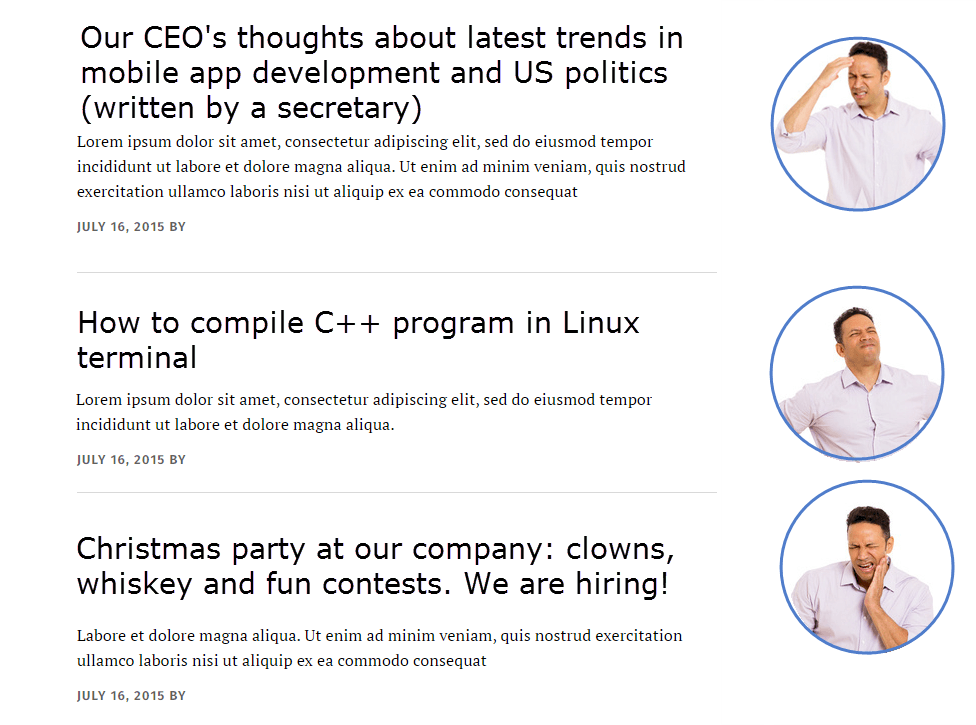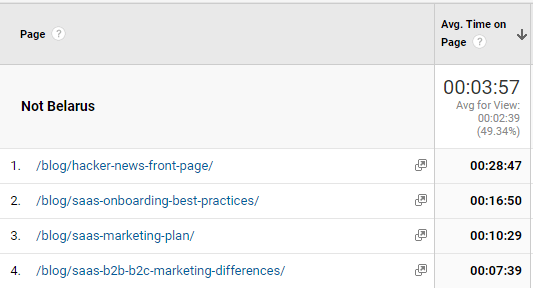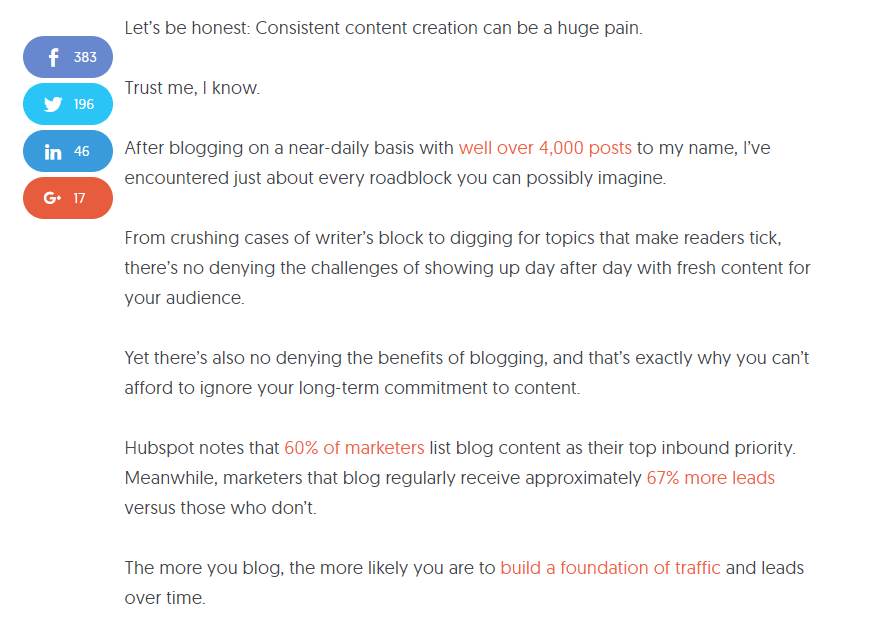You can hear from all points of the compass that content is king and inbound marketing is the way to brave a new world. So every company is blogging now.
But unfortunately, a lot of blogs suck. And what’s about your corporate blog? Our alchemists have created a scale which helps you determine how good your content is.
How Can Kraftblick Help Your Software Company?

- We build marketing strategies from scratch and fix existing ones. More about that here.
- We provide consultations to company owners, directors, heads of marketing and sales, marketers. This is how we do it.
See you soon 🙂
The scale has three divisions: Sh*t, Ok and Sweet. Let’s discuss them step by step.

Part 1: Sh*t
We think that content strategy needs a serious boost if the information below describes your blog.
The Goal
The blogging goal is not clear, or the same blog has several different goals. If you don’t know the direction, there is a little chance you will come to the right place.
Here are some examples of poor goals:
- We are blogging because content marketing is king and every company is doing it.
- Our blog was born to tell the world that the company is alive and something happens here. (Usually, in this case, the latest post was published in 2014)
- The goal is to publish 4 posts monthly. As a result, we will have 48 posts published yearly.
It’s easy to recognize a blog without a goal. It’s a set of topics: useful information for clients is mixed with boring press releases and articles written without a purpose.

Topic Selection and Audience
Even if the goal is as clear as vodka, topics are selected based on unknown factors. Usually, a wrong buyer persona is targeted.
Latest example from our prospect: the company develops software for HR departments of mid-size businesses and enterprises. But for some reason all of their blog posts are looking like this:
- How to find a job if you have no experience at all
- How to create an outstanding CV
- How we celebrated the birthday of Mike, our CEO.

As we can see, most of the posts are useless for top managers of HR department. There is only one exception. If they forget to congratulate Mike, they may need to find a new job.
Writing Style
Poor blog posts are written based on first three Google results on the selected topic. Usually, they are generated by low-cost copywriters who produce 3,000 words per day to buy some food.
No research, no experience, no facts, no numbers. “Lorem ipsum” looks like a bestselling novel compared to these masterpieces. Just look at this example:
You can find more info in the post 3 big lessons we learned after hiring cheap freelancers to write high-quality content, written by our CMO Irina.
Length
Weak blog posts are mostly up to 500 words long. This length is not enough to tell something meaningful.
However, there are some exceptions, when this length is ok:
- You have a corporate dictionary. For example, like this dictionary of accounting terms
- You can add a comprehensive and useful answer and stay under 500 words:

In other cases, the audience is expecting to get a bit more info than a few sentences.
Illustrations
Poor texts usually contain no images at all or maybe one dumb photo stock image.
Why are images important? Articles with images get more traffic and shares. You can see this post on BuzzSumo for details.
But we all know the texts like this one:

Nobody wants to read them. By the way, this is a tip how to become a millionaire in three easy steps. That’s why we have so few rich people — nobody can read the whole post. Just kidding.
Photo Stock images are little better, because now they are looking like visual garbage. Hi, Mr businessman:

Design
Poor posts are visually unappealing.
- The font is so small that you need a magnifier to discern something.
- The paragraphs are endless as a Russian winter.
- The rows are so long that you can fall asleep before your eyes reach the end.
- No formatting, bullets, quotes. Just a monotonous text.
Recommendations
In case you’ve realized we were talking about your typical posts, there are two things you can do:
A) Just stop wasting your time and energy on this senseless activity. In most industries it’s better to have no blog at all than to produce generic spammy posts.
B) Rethink your strategy and apply it in the right way.
The next steps may be as follows:
- Determine the goal of the blog.
- Analyze the best content in your industry.
- Create a buyer persona. And read our post if you want to do it for software company.
Part 2: Ok-blog
If you read the information below and feel that it’s about your corporate blog — congratulations, it’s ok. You will not win the Oscar, but at least you can look in the eyes of your readers.

If you’ve earned less than four points — your blog is still on the way from sh*t to ok, so keep moving forward.
The Goal
The blog has a clear goal which corresponds to business goals. This may be:
- Get more traffic
- Get more leads
- Hire best talents (if it’s an hr-blog)
The goal should be crystal clear to all people who are involved in the writing process. Just look how Neil Patel even made the goal public:

Topic Selection and Audience
Ok-blogs editors know their buyer personas. And most of the topics are created to help potential clients solve their problems.
But beware: described buyer persona doesn’t mean it’s described in the right way.
Let’s take an example from the real life.
A software company focusses primarily on MVP and mobile apps development for early stage startups. The company puts a lot of resources into content creation. They come up with lots of topics like these:
- How to install the Android SDK
- Latest news in the RoR world
- The guide on SWIFT issues
The blog generates almost no leads. After investigation, it became clear that company’s perfect clients are not geeks. They are founders WITHOUT technical knowledge. So the company switched the content focus from “let’s code better” to “let us help you with mobile apps and MVP”.
Writing Style
The OK-articles are not based on first three Google results. Authors scan the page to the end and (unbelievable!) sometimes even open the second page.
But usually, these posts are lacking some practical utility. You read these articles and cannot determine whether they are written for humans or for robots.

Just ask your colleagues whether they are reading your blog constantly or not. If the answer is “Sorry bro, I thought it’s for SEO”, it’s time to think about some improvements.
Length
Usually, ok-posts are around 1,000 words. But in some industries, they may be even longer. For example, all marketing people know that posts should be 1,500+ words.
As a result, authors need to spit out some more sentences to hit the target. By the way, that’s the point where I’m staying at the moment 🙂
Illustrations
The ok-posts usually have more than one illustration. It’s because companies have purchased more advanced pricing plans on photo stock. As a result, most of the images are still looking a bit photostocky.
But here or there you can find some screenshots and custom charts in these posts.
Design
At least 50% of the design issues listed in the previous section are fixed. Posts still may look a bit boring and generic, but at least they don’t feel like 1999.

Recommendations
If your blog is just ok, it doesn’t mean you’ve reached the end of the journey. Be fair with yourself: posts written for good rankings in Google are slightly better than awful sh*tty posts generated without any goal in mind.
The next steps may be as follows:
- Rethink the writing strategy. Stop generating tasks for writers automatically based on keyword research.
- Check out your buyer persona carefully and make sure you are writing for the right audience.
Part 3: Sweet Blog
And now we’ve reached the final destination. Sweet posts are the Holy Grail of content marketing. They bring you traffic, leads, and much more goodies. Let’s check out how these posts may look like.
The Goal
The goal is crystal clear and usually has some KPIs assigned. It may look like this:
- Get 10,000 organic visitors in Q3
- Get 100 leads in June.
What’s more important, people responsible for sweet blogs strategy have clear plans how to achieve these goals.
For example, the goal sounds like “get 1,000 additional visitors in July”. In this case, we need to calculate how many users are visiting each new post monthly in average. If this number is 200, we need to write five more posts to reach the goal.
Topics
A buyer persona is described so well that you want to invite him for Thanksgiving. All topics are based on real problems your potential clients encounter daily.
Writing
Sweet posts are not generated spammy texts based on first Google results. The text is written in one of the following ways:
- The author is an industry expert and has a deep understanding of the topic he writes about. Take, for example, Neil Patel who is a content marketing guru and writes on topics connected with content production, promotion and many more.
- The author spent a lot of time researching studies, articles, and books related to the topic. Check out this post about Procrastination written by Tim Urban.
- The author interviewed an industry expert and crafted the post based on conversation. For example, one of our marketing specialists interviewed Ricky Sharma – Marketing Director at EC English Language Centres.
- The author has performed a research study and now shares the results with the audience. For example: “We Analyzed 1.3 Million YouTube Videos. Here’s What We Learned About YouTube SEO”.
Length
Just look at the examples mentioned above. All of them are 1,500+ words long. And you know what? People are really reading big fat posts if they think there is something helpful and interesting inside. Just look at our Google Analytics data

Illustrations
Sweet posts writing requires a photo stock-detox. Each illustration should solve one of these issues:
A) The picture explains what we are talking about. The following types of images are usually used for this purpose:
- Charts
- Infographics
- Screenshots
B) These types of pictures also can make reading funnier:
- Cartoons
- Gifs
- Custom illustrations
- Upgraded images (even if they originally came from photo stock).
The basic rule of thumb: no page screen without an image:

Design
The sweet posts are all about catching the attention. And while we are reflecting on whether it’s necessary to add a bullet list, Neil Patel makes paragraphs one-two rows long:
 Source:neilpatel.com
Source:neilpatel.com
Recommendations:
If your posts are shining, there are two things you need to do:
- Produce even more posts like these. More posts = more results.
- Promote your diamonds to make more people happy.
Conclusions:
1) If you write generic senseless articles just because “everybody is doing it” — consider changing the strategy or even reinvesting these resource into other projects. Writing gods are currently not accepting these sacrifices.
2) If your company’s blog is ok — consider investing some more time and money to make it great. You will get much more results in this case.
3) If you produce masterpieces, just keep going. And don’t forget to promote the work you are doing.
